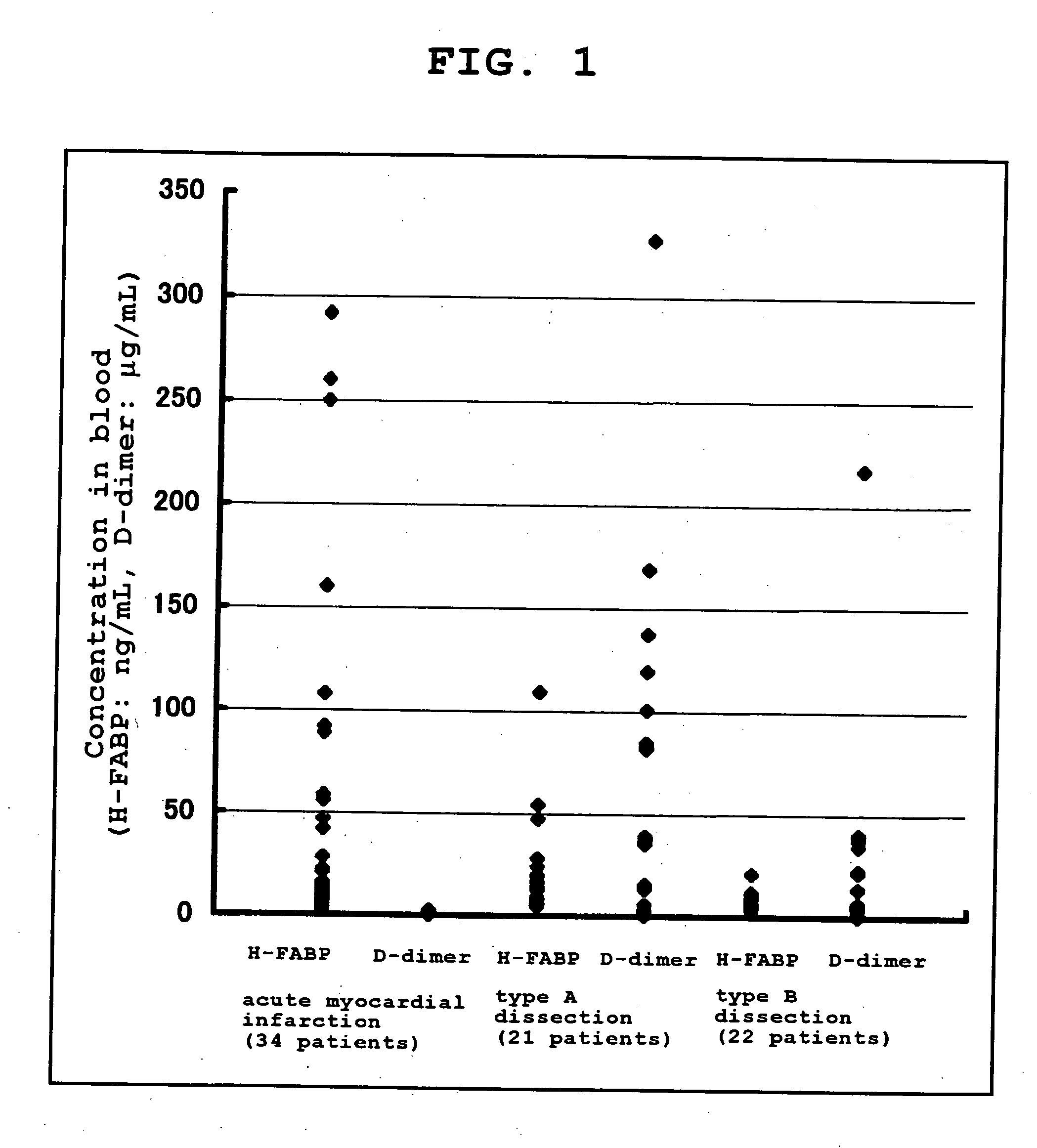Method of Distinguishing Among Type a and Type B Acute Aortic Dissection and Acute Myocardial Infraction and Kit For Distinguishment
a technology of acute aortic dissection and kit, which is applied in the field of distinguishing between acute aortic dissection and acute myocardial infraction and kit for distinguishing, can solve the problems of difficult to distinguish between acute aortic dissection and acute aortic dissection, and the difficulty of clinical symptoms between the two diseases
- Summary
- Abstract
- Description
- Claims
- Application Information
AI Technical Summary
Benefits of technology
Problems solved by technology
Method used
Image
Examples
example 1
Measurement of D-Dimer and H-FABP in Blood from Patients with Stanford Type A Acute Aortic Dissection, Stanford Type B Acute Aortic Dissection, and Acute Myocardial Infarction
[0085]Of patients who visited a hospital with a complaint of chest pain (including chest back pain), those having the established diagnosis of acute aortic dissection (43 patients in total, consisting of 21 patients with Stanford type A and 22 patients with Stanford type B) and those having the established diagnosis of acute myocardial infarction (34 patients) had their blood drawn at the time of visit, and the D-dimer concentrations and H-FABP concentrations in the blood samples were measured as described below.
[0086]Note that informed consent was obtained from these patients.
(1) Measurement of D-Dimer
[0087]D-dimer concentrations were measured using “STA Liatest D-dimer” (trade name, manufactured by Roche Diagnostics, Inc.), a D-dimer assay reagent adopting the latex aggregation method as the measurement princ...
example 2
Distinguishment Among Individual Diseases-1
(1) Establishing a D-Dimer Cutoff Value
[0094]For the measured values obtained in Example 1, ROC curve analysis was performed using the ROC analytical software program “MedCalc” (trade name, Med Calc Software Company [Belgium]), and a D-dimer cutoff value that makes it possible to distinguish between the acute aortic dissection group and the acute myocardial infarction group was established. The value calculated from the ROC curve (FIG. 2) was 2.4 μg / mL.
(2) Establishing an H-FABP Cutoff Value
[0095]For the measured values obtained in Example 1, an H-FABP cutoff value that makes it possible to distinguish between the group consisting of the acute myocardial infarction group and the Stanford type A acute aortic dissection group and the Stanford type B acute aortic dissection group was established. The value calculated from the ROC curve (FIG. 3) was 6.7 ng / mL.
(3) Calculation of Diagnostic Efficiency
[0096]Diagnostic efficiency was calculated fro...
example 3
Distinguishment Among Individual Diseases-2
[0100]Diagnostic efficiency for each disease was calculated in the same manner as Example 2 using the reference value (400 ng / mL) for the reagent used in Example 1 as the D-dimer cutoff value and the cutoff value (6.2 ng / mL) for evaluating acute myocardial infarction established for the reagent used in Example 1 as the H-FABP cutoff value, and a comparison was made with the cases of each marker used alone.
TABLE 3Diagnostic Efficiency of the Present Invention forIndividual Diseases (77 Patients in Total) (Comparedwith Cases of Each Marker Used Alone)Diagnosticsensitivity(%)DiagnosticDiagnosticDiagnosticTargetcriteriaefficiencyspecificitydiseaseD-dimerH-FABP(%)(%)Type APositive58.495.2 (20 / 21)acute(45 / 77)44.6 (25 / 56)aorticPositivePositive68.881.0 (17 / 21)dissection(53 / 77)64.3 (36 / 56)Type BPositive54.586.4 (19 / 22)acute(42 / 77)41.8 (23 / 55)aorticPositiveNegative81.850.0 (11 / 22)dissection(63 / 77)94.5 (52 / 55)AcutePositive55.876.5 (26 / 34)myocardial(43...
PUM
| Property | Measurement | Unit |
|---|---|---|
| time | aaaaa | aaaaa |
| volume | aaaaa | aaaaa |
| volume | aaaaa | aaaaa |
Abstract
Description
Claims
Application Information
 Login to View More
Login to View More - R&D
- Intellectual Property
- Life Sciences
- Materials
- Tech Scout
- Unparalleled Data Quality
- Higher Quality Content
- 60% Fewer Hallucinations
Browse by: Latest US Patents, China's latest patents, Technical Efficacy Thesaurus, Application Domain, Technology Topic, Popular Technical Reports.
© 2025 PatSnap. All rights reserved.Legal|Privacy policy|Modern Slavery Act Transparency Statement|Sitemap|About US| Contact US: help@patsnap.com



